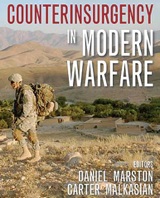Counterinsurgency in Modern Warfare – Book Review
 Counterinsurgency in Modern Warfare. Editors Daniel Marston and Carter Malkasian. Osprey Publishing Ltd., 2008. Hardback. 304 pages. $27.95.
Counterinsurgency in Modern Warfare. Editors Daniel Marston and Carter Malkasian. Osprey Publishing Ltd., 2008. Hardback. 304 pages. $27.95.
We hope that this book can serve as a starting point for those looking to understand the principles and history of counterinsurgency, an understanding that is an essential starting point when devising a successful counterinsurgency strategy for current and future campaigns.
This book strives to bring current events into a concise perspective through examination of past events, as insurgencies become a larger and larger part of conflicts in the beginning of this century. Counterinsurgency in Modern Warfare covers 13 different insurgencies from the last 110 years with each chapter contributed by a different author.
{default}These authors all have impressive credentials and represent a good cross section of academia and the military. The focus of each is to highlight the different insurgencies, what methods were employed to subdue them, what worked, what didn’t, and an end result. I found the book to be thought provoking, adding greatly to my understanding to some events that have occurred in my lifetime. It dispelled some misconceptions and gave rise to a desire to seek more information. Extensive footnoting and a well-stocked bibliography will serve the reader well.
A number of chapters are especially well written and informative, particularly those that cover the Philippines 1898 – 1954, Rhodesia 1962 – 1980, Northern Ireland 1967 – 2007 and Afghanistan 2001 – 2007. This is not to say that any of the others are without merit—I devoured this book—but it is difficult for each of the authors to present the information in 18 to 22 pages, and some do a better job than others. That is what makes the bibliography so important; it is key in steering those who desire more information to other sources.
Each chapter could fill a book by itself. The editors focus on the fact that not any one explanation will work in every situation. A key point that does recur is that the political and military aspect must work hand-in-hand to push towards success. Often this success can occur even while the media may be portraying failure. The British were actually winning in North Ireland, I discovered in the book, but my perceptions based on publicly available information had led me to believe they were losing at the time.
Another important point is that brute military force rarely succeeds, as exemplified by the actions of Germany in Russia during World War II. This issue is addressed again and again in the chapters on Vietnam, French operations in Algeria and Vietnam, and the Israelis in the Al-Aqsa Intifada. The media was present in all of these campaigns and not always in a helpful way for the government under attack. The media is becoming all the more important as part of the success equation with the rampant explosion of the Internet and the fact that anyone can now become a direct news source with the click of a mouse or the sending of a text message. Failure to contain, direct or refute "news" will only make the task at hand more difficult.
The editors sum up the book best, saying, "We hope that this book can serve as a starting point for those looking to understand the principles and history of counterinsurgency, an understanding that is an essential starting point when devising a successful counterinsurgency strategy for current and future campaigns." Counterinsurgency in Modern Warfare is a good buy and an asset to anyone’s library.
Michael Peccolo is a retired Armor Major from the US Army with overseas duties and commands and also with assignments in recruiting and ROTC. He lives in Tennessee where he raises horses with his wife.
ACG Intel

